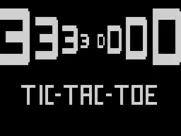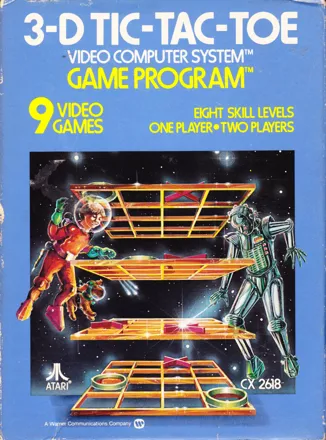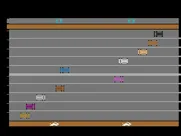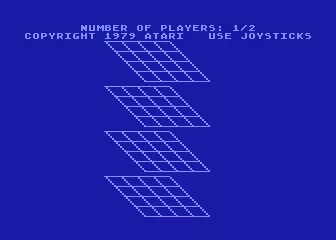3-D Tic-Tac-Toe
-
 3-D Tic-Tac-Toe
(1978 on
Apple II,
TRS-80,
Commodore PET/CBM)
3-D Tic-Tac-Toe
(1978 on
Apple II,
TRS-80,
Commodore PET/CBM)
-
 3-D Tic-Tac-Toe
(1980 on
TRS-80)
3-D Tic-Tac-Toe
(1980 on
TRS-80)
-
 3-D Tic-Tac-Toe
(1983 on
TRS-80 CoCo)
3-D Tic-Tac-Toe
(1983 on
TRS-80 CoCo)
Description
3-D Tic-Tac-Toe is, as the name implies, a 3D version of Tic-Tac-Toe. The object of the game is to place four X's or four O's in a horizontal, vertical, or diagonal row on the 4x4x4 board.
There are nine games of which the first eight games are for one human player against the computer. The numbers 1-8 represent the skill level. Game 9 is a two player game. In the DOS version there are only two difficulty settings and no two player game.
Groups +
Screenshots
Credits (Atari 8-bit version)
| By |
Reviews
Critics
Average score: 40% (based on 7 ratings)
Players
Average score: 2.4 out of 5 (based on 34 ratings with 2 reviews)
The Good
I remember playing this game at my grandparent’s house during vacations. We had our own 2600 Video Game System, but my grandparents had additional games we didn't, including 3-D Tic-Tac-Toe.
The flexibility of 3D Tic-Tac-Toe was one of the things I enjoyed most about it, because it allowed you to either play against a human opponent, or against the computer. Furthermore, you could increase the difficulty level of the computer, making for a much more challenging game.
Playing against a human player was the most enjoyable way to play the game for me, because most humans (especially those who had never played this game before) didn't see every single weird possible winning move, and it was actually possible to win against another human. Playing against the computer, even on the easy levels, I seldom stood a chance.
More than any other reason, I enjoyed this game because of its originality. The amount of thinking required to win this game was analogous to going from Checkers to Chess... or from Chess to 3D Chess. The 3-dimensional element of 3D Tic-Tac-Toe breathed a whole new life into the game. It was now possible to move beyond the endless series of stalemates that commonly occurred when I would play traditional tic-tac-toe.
The Bad
The amount of processing power this game requires can extend the amount of time it takes to play a round half-way towards infinity! It's not much of a problem when playing the beginner games, and certainly isn't overly noticeable... the CPU takes just a few seconds to make its move. Yet on the higher levels, the limited Atari 2600 CPU just can't make a choice very quickly. The process of analyzing all the possible moves, countermoves, and so forth slow the game down to a crawl.
Going back to my childhood, when I used to play this game somewhat frequently, I remember how long it took the CPU to think when you had the game set to the most advanced of the difficulty levels. Sometimes, if you made a move that REALLY made the Atari 2600 think, I recall that it could take ten minutes or more to finally decide upon a move! I have also heard from some other avid players (who played it far more than did I) that they have seen it sit on a blank screen for close to half an hour before making a move! That's plenty long enough to go eat Lunch while waiting for the game to make its move! And as a child, that amount of waiting is excruciating.
Last of all, the frustration level of playing this game can often be a huge discouragement. After failing to win the first dozen or so games, 3D Tic-Tac-Toe seems to loose it’s enjoyment factor completely. Of course, if you have strategic tenacity, you may never tire of this game. I did, however, so I only play it for rare, nostalgic purposes these days.
The Bottom Line
3D-Tic-Tac-Toe is an extremely challenging game, and one of the best strategy games I have ever played on the Atari 2600 platform. Rather than stick with a traditional game of tic-tac-toe that would quickly become tedious for most, the designer of this game decided to take the classic game to a whole new level!
The game board is actually separated into four separate boards, and each are 4x4 instead of 3x3, giving ten possible winning directions on each playing board, instead of just eight. The four boards are positioned one above another, in a sort of free-floating stack.
Because there are four boards on the screen, it increases the winning combinations to forty, if the winning move is focused on just one of the boards. Yet once you have played the game, you will suddenly realize that a winning move can also be made< i>through the four playing boards, thus adding the three-dimensional aspect of the game! When you see how this is done, you will suddenly understand that the true challenge of this game is introduced when you add the strategy of three dimensions. And thus the total number of winning moves leaps above one hundred.
The challenge of this game is quickly discovered because it is not easy to think three-dimensionally when playing tic-tac-toe. It's like going from a slide-tile game to a Rubik's Cube. With a possible move being possible in so many directions, a single mistake can (and often will be) fatal. Plus, with so many directions for the computer to win, it is hard keeping an effective defense in place.
3D Tic-Tac-Toe is a fascinating game for the Atari 2600, and it is definitely worth trying. You may quickly become frustrated, but then again, it's all part of the game!
Atari 2600 · by SirOrlando (218) · 2005
The Good
There aren't many exciting things you can do with a straight-forward implementation of three-dimensional Noughts and Crosses, but there is a whole lot you could do wrong. This version commits no devastating mistakes, which is somewhat surprising considering it's written in BASIC, and was done very early in the IBM PC's life.
The oblique perspective of the playing field looks nice and lets you pretty easily evaluate the game state. Enemy moves are animated for a couple of seconds, which helps you analyze what has specifically changed about your situation. Moves have to be typed in as coordinates, there is no arrow key selection of fields or anything like that, but together with the on-screen axis legends you'll quickly get the hang of it.
Two difficulty levels are available for the computer opponent, which calls itself "Wizy" in the introduction screen, but "Compy" during gameplay. It doesn't seem to make mistakes on the harder level, and is still a pretty decent player on the lower one. You'll have to keep a good eye on its moves, especially for those tricky to detect multi-level diagonal lines. The computer will not overlook a possible winning move, and be eager to block you from making one, as well. The analysis of the game board seems pretty thorough considering how little code there is to the algorithm (the game was most often distributed in source form, so it's easy to check it out).
I usually get bored of simple rule-based games like this almost the minute I start playing them, but three-dimensional Tic-Tac-Toe seems to be a little less trivial than its flat sibling, and I was surprised how often I actually felt like playing another round. That definitely doesn't happen to me for games like regular Tic-Tac-Toe, Connect Four, or Reversi, which I draw more frustration from than enjoyment.
The Bad
The game doesn't offer a two-player mode, you can only play alone against the computer. With all the implementation for graphics, player input, and checking for winning conditions already in place, that seems like a strange omission. It also has a bug that makes it not count some rounds in the scoring, making the summary after each game worthless.
Most vicious, though, is the title theme playing through the PC speaker when starting the game. Not only is it as loud and harsh as the worst among PC speaker music, it's also just a few notes short and repeated around half a dozen times. Why? Just because a machine has a feature doesn't mean it absolutely has to be used.
The Bottom Line
It's a competent early implementation of a simple, traditional game concept, and the computer opponent's challenge makes it fun to play, even in 2021, even for several rounds. If you feel like playing a single-player round of good old three-dimensional Tic-Tac-Toe, the only major argument against booting up this version is the opening theme. Thank goodness that you can turn off sound in an emulator, because on original hardware, it must have been worth considering to open the case and disconnect the beeper each time before launching the game.
DOS · by Daniel Saner (3515) · 2021
Trivia
Blank Screens
You will notice that when you are playing against the computer in 3-D Tic-Tac-Toe, the screen will go completely BLANK when the computer is thinking. The purpose for this is to free additional CPU time for thinking rather than using precious processing cycles to draw the screen 60 times per second. This technique can be seen in other Atari 2600 games as well. For instance, when playing the computer in Othello, the harder levels will often blank out the screen for a second or two in order to decrease the wait time for the human player.
In the case of 3D Tic-Tac-Toe, however, the complexity is so much greater that it is hard to keep track of who has gone where. Having the screen go blank, therefore, introduces the possibility of a programming glitch that I have heard theorized about on more than one occasion. Some say that the Atari 2600 3-D Tic-Tac-Toe computer opponent cheats!
I have not confirmed this for sure, but considering that the screen does conveniently blank out between moves, it is conceivable that changes are made that would go unnoticed by the human player! It may also explain why I rarely won when playing against computer. If this is the case, it is probably a programming bug, as it is very unlikely that a game programmer for a commercial company as large as Atari would blatantly introduce cheating on the part of the computer.
Development
3-D Tic-Tac-Toe originated as a popular BASIC game. It was already included in David Ahl's influential book BASIC Computer Games in 1978, where it is stated that the game comes from Dartmouth College.
Film homage
3D Tic-Tac-Toe was programmer Carol Shaw's first published game. Shaw would eventually leave Atari for Activision, where she developed the more famous River Raid.
Additional information contributed by General Error and mister_g.
Analytics
Upgrade to MobyPro to view research rankings and price history! (when applicable)
Identifiers +
Contribute
Are you familiar with this game? Help document and preserve this entry in video game history! If your contribution is approved, you will earn points and be credited as a contributor.
Contributors to this Entry
Game added by Indra was here.
Plex Arcade added by firefang9212. Xbox 360, Windows added by Alaka. DOS added by General Error. Antstream added by lights out party. Atari 8-bit added by LepricahnsGold.
Additional contributors: General Error, SirOrlando, Patrick Bregger, mister_g.
Game added May 22, 2004. Last modified July 17, 2024.



















